April 9 2012
1
09
/04
/April
/2012
15:26
I have compiled a list of sources for the elements that are available to the amateur chemist. Tellurium will be discussed here.
Tellurium is a brittle, semimetallic element in the chalcogen group. It is one of the rarest elements in the earth's crust. Tellurium is quite unreactive and does not dissolve in acids. Tellurium forms hexavalent covalent compounds such as the hexafluoride, which are quite low melting and reactive. Tellurites and tellurates, however, are the more commonly used tellurium compounds, as the alkali metal salts are water soluble. Tellurium occurs in the anode sludge when copper is refined, as well as in some selenium minerals. When tellurium is metabolized in the human body, it produces ethyl telluride, which smells very strongly of garlic.
In element form: Tellurium copper, a rare alloy of copper, contains about 0.5% tellurium. Tellurium is used in some old photocopiers instead of selenium.
In compound form: Tellurium suboxide is used in rewritable CDs and DVDs. Thermoelectric heaters (peltier plates) use lead or bismuth telluride as the semiconductor to produce the hot and the cold sides.
Here is my sample of tellurium. It is a DVD-RW.
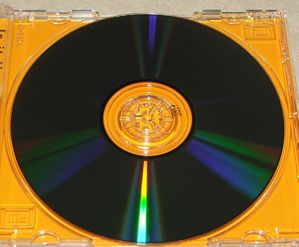
Published by LanthanumK
-
in
Elements
April 7 2012
6
07
/04
/April
/2012
15:58
I have become interested in mini-thermites, thermites that are relatively safe and interesting. Magnesium, being more reactive than aluminium and still quite stable, appears to be the reducing metal of choice. The heat wave created by a magnesium thermite is so intense that it blows the chemicals apart after ignition, prevent any coalescing of liquid metal. This is bad for most thermite applications but good when intense heat is quite undesirable. Grinding magnesium on a file is relatively easy; the provided scraper with the firestarter makes larger pieces (less desirable) with more difficulty than the file.
I had previously prepared iron(III) oxide hydrate by electrolytically oxidizing iron in aqeuous solution and filtering the precipitate formed. The powder is mixed and ground with the magnesium dust to form a brown mixture that looks to be highly reactive and a lot of fun. The following sentence is not true, but was written initially: Ignition will be with a magnesium strip, not the dangerous mischmetal flint, because of the decreased size of the magnesium.
This thermite failed with titanium thread ignition, steel wool ignition, and mischmetal - magnesium ignition. This was because first, there was too much excess iron(III) oxide. Second, the iron(III) oxide was hydrated, making it unlikely to burn.
So I made a new mixture. I heated the iron(III) oxide to dehydrate it. I then mixed it with an excess of magnesium shavings, since they will burn even when no iron(III) oxide is present. I then scraped up a large amount of magnesium shavings and powder. I placed the thermite mixture on a brick, then piled the shavings on top. On top of that, I placed the easily ignitable powder. I then ignited the powder. Since the shavings take a second to ignite, it gave me enough time to retreat before the reaction began. I ended up using a mischmetal flint just because it was the easiest way at the time. The reaction was quite silent and slow compared to copper, but it was much hotter because of this.
Here is the video of the second trial.
Published by LanthanumK
-
in
Experiments
April 7 2012
6
07
/04
/April
/2012
14:49
I have compiled a list of sources for the elements that are available to the amateur chemist. Antimony will be discussed here.
Antimony is a bluish-gray brittle semimetal. It is insoluble in non-oxidizing acids, but dissolves in oxidizing acids. It burns in air with a bluish flame to produce white antimony trioxide. Antimony is quite toxic, though not as toxic as arsenic. Antimony is found in the earth as stibnite, an antimony sulfide mineral. This is reacted with scrap iron to make antimony metal. When antimony is precipitated from solution, it is a black powder like many metals when precipitated. Antimony strengthens lead and tin alloys.
In element form: Stibnite can be dissolved in concentrated hydrochloric acid and reacted with zinc metal to precipitate amorphous antimony metal. Antimony-tin alloys can be dissolved in HCl, leaving antimony behind. Most lead-acid batteries have antimony alloyed in their electrodes. Pewters generally contain antimony.
In compound form: Some match heads have antimony trisulfide in them.
Here is my sample of antimony. It is powder produced from a pewter alloy in hydrochloric acid.
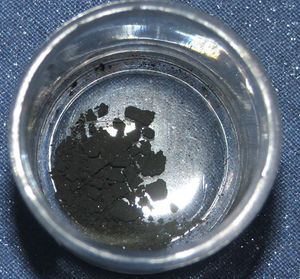
Published by LanthanumK
-
in
Elements
April 6 2012
5
06
/04
/April
/2012
14:51
Please post your basic inorganic chemistry questions in the comments section below.
Published by LanthanumK
April 6 2012
5
06
/04
/April
/2012
14:39
I have compiled a list of sources for the elements that are available to the amateur chemist. Tin will be discussed here.
Tin is a soft, whitish-gray metal in the carbon group. Tin is moderately reactive and quite resistant to corrosion by air or water. It dissolves slowly in hydrochloric acid, forming a colorless solution of tin(II) chloride. Tin(II) chloride is a reducing agent, capable of reducing copper(II) chloride to copper(I) chloride, for instance. Tin also forms a tetravalent state, which is predominantly covalent. Cassiterite, composed primarily of tin dioxide, is tin's primary ore. Tin forms two allotropes, one of which (beta tin) is shiny, soft, and metallic; the other, alpha tin, is grayish, dull, brittle, and nonmetallic. Addition of elements like antimony prevents the change of beta to alpha at cold temperatures. Tin's compounds are mostly colorless but its iodides are bright red or orange.
In element form: Galinstan, found in Geratherm mercury-free fever thermometers, contains about 10% tin. Tin-lead solders contain about 60% tin. Most common lead-free solders are about 98% tin. Electrolytic oxidation and then reduction of any tin alloy produces pure tin at the cathode. Bronze contains tin.
In compound form: Indium tin oxide is used as a transparent electrode in LCD screens. Tin dioxide is also used in many ceramics.
Here is my sample of tin. It is electrolytically purified powdered tin from a pewter object.
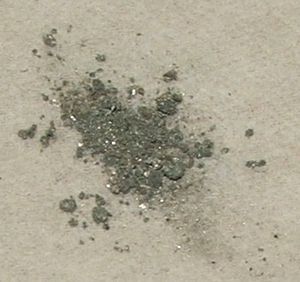
Published by LanthanumK
-
in
Elements
April 6 2012
5
06
/04
/April
/2012
14:28
Many chemicals form hydrates, where water molecules are bound to the chemical molecules. These hydrates often have different colors and different properties. For instance, anhydrous stannic chloride is a corrosive, fuming liquid, while the pentahydrate is an acidic white solid.
Copper(II) chloride has two forms: a brown anhydrous form and a blue-green dihydrate form. Because of excess HCl, my copper(II) chloride hydrate is more green than blue. When it is heated gently, it turns brown and releases both water vapor and white fumes, showing that the excess HCl and the water have been released from the crystal structure.
Here is a picture of the resulting product, with the original dihydrate for comparison.
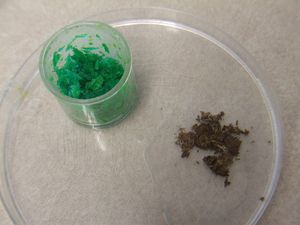
Since the dehydration required heat, the reaction is likely endothermic. Therefore, rehydration should be exothermic. It is. However, because the anhydrous copper(II) chloride had been heated too vigorously, there was some decomposition to HCl and CuO and the solution formed when it was placed in water was cloudy. Here is the video of the reaction when two drops of water are added to the bulk of the anhydrous substance.
I then tried burning a crystal of copper(II) chloride with a magnifying glass. The copper(II) chloride refracted the green coloration for a moment before they turned brown as they were dehydrated. Then they turned black and melted. The resulting liquid was quite mobile. When cooled, it forms a black amorphous solid.
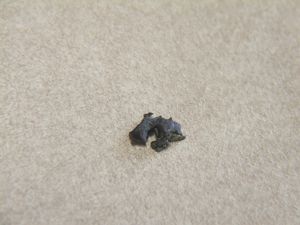
This dissolves in water, forming a mixture of copper(II) chloride solution (green), copper(II) oxychloride precipitate (green), and copper(I) chloride precipitate (white). The copper(I) turns to the oxychloride upon exposure to air. The black lump completely dissolves.
If I do the same with copper sulfate, I will post the results in this article.
Published by LanthanumK
-
in
Experiments
April 5 2012
4
05
/04
/April
/2012
15:19
I have compiled a list of sources for the elements that are available to the amateur chemist. Indium will be discussed here.
Indium is an extremely soft, silver-gray metal. It is found under aluminium in the post-transition metal area. Indium is moderatley reactive and dissolves with ease in strong acids. Its oxide is amphoteric, meaning that it is soluble in both acids and bases. Indium compounds are colorless or white and acidic, making them uninteresting. Indium metal, however, is extremely malleable and retains this characteristic to cryogenic temperatures. Indium can be used to seal gaps because of its tendency to stick to other metals, acting like a superior form of paraffin wax. Indium metal is quite expensive, with a current price of about 250 USD per pound.
In element form: Galinstan, a liquid metal alloy used in Geratherm mercury-free fever thermometers, contains about 32% indium. Indium is often used in specialty solders. Field's metal, used in some low-melting seals for fire sprinkler systems, contains indium. The brass pin in the center of AA or AAA alkaline batteries is often plated with indium to prevent the zinc from passivation.
In compound form: LCD screens use indium tin oxide (90% indium oxide) for transparent electrodes. Indium is found in most LEDs.
Here is my sample of indium. It is a piece of pure indium metal from GalliumSource LLC. This is only a small piece, flattened to a foil by gentle pressure.
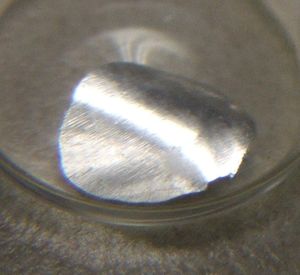
Published by LanthanumK
-
in
Elements
April 4 2012
3
04
/04
/April
/2012
15:39
This experiment involves reduction of copper(II) oxide, a black water-insoluble powder, with magnesium metal. The reaction is CuO + Mg -> MgO + Cu. The reaction is quite exothermic. Do this away from all flammable materials. Do not get too close to the reaction as burning metal can spray all over with larger quantities. This reactions is commonly known as a thermite.
Grind a magnesium rod or bar into shavings or, better yet, powder using a knife or a file.
Precipitate copper(II) carbonate from a solution of a copper(II) salt by adding sodium bicarbonate. Filter, wash, and dry by heating. It will turn black as it decomposes to copper(II) oxide. If you just have copper metal, electrolytically oxidize the copper in a sodium bicarbonate solution to form copper(II) carbonate. Heat this paste after filtering and drying.
Using a mortar and pestle, grind equimolar amounts (approximately 3 g CuO to 1 g Mg) of these two chemicals together until the mixture is uniform.
Place on a metal surface in a small pile. Ignition using a ferrocerium flint can be dangerous as the hands will be very close to the mixture. A better method of ignition would be electric ignition using a very thin piece of titanium foil and a nine volt battery or a magnesium ribbon.
Despite the dangers, I used a ferrocerium flint to ignite the mixture. Since there was some wind, I was afraid that the thermite mixture would blow away after placing it out in the open piece of metal. Therefore, I ignited it right away.
If you will try this at home, please be more careful than I was.
The "Shoe for Comparison" picture malfunctions in the video.
I then tried a copper(II) sulfate reduction. Aqueous copper sulfate reacts quite vigorously with magnesium metal, but the crystals react yet more vigorously. I shredded some magnesium and ground the copper(II) sulfate - magnesium shaving mixture together with the end of a pen. I then placed it on the same metal dish in a small pile and added some more magnesium shavings on top. Since grinding magnesium is so difficult, I hardly produced enough magnesium on top to ignite the mixture, so I had to strike the ferrocerium for a couple minutes before I actually got it ignited. The top layer burnt with a dazzling white flame, but the bulk was still unburnt. It would not ignite. Here is the video of the ignition.
I retried this with more finely powdered magnesium and dehydrated copper(II) sulfate. The result was much better.
Published by LanthanumK
-
in
Experiments
April 4 2012
3
04
/04
/April
/2012
15:17
I have compiled a list of sources for the elements that are available to the amateur chemist. Cadmium will be discussed here.
Cadmium is a soft, blue-gray metal that is considered borderline between the transition metals and the post-transition metals. Like the post-transition metals, it forms primarily one oxidation state, its compounds are generally (although not completely) colorless, and it is soft and low-melting. However, it is in the d-block, so it is technically a transition metal. Cadmium is toxic and replaces zinc as a heavy metal poison. Cadmium is moderately reactive (more so than mercury but less so than zinc), so it dissolves easily in hydrochloric acid, forming hydrogen and a colorless solution. Cadmium sulfide, however, is bright yellow. The oxide can be brown (the other form is white), and the selenide is red. There are few other colored cadmium compounds.
In element form: Nickel-cadmium batteries supposedly contain cadmium metal at the anode, but I have never been successful in extracting any cadmium from a "sub-C" cell battery. Little rechargeable button cells (LR1130) contain a gray paste at the anode that is probably cadmium metal mixed with a binder. Cadmium plated bolts and screws used to be relatively common, and can be distinguished from zinc by the increased softness of the coating.
In compound form: Cadmium sulfide was used in cadmium yellow pigment, but has been almost completely discontinued due to toxicity. Cadmium sulfide is still used in photodetectors as the orange line separating the two electrodes because of its change in conductivity due to light.
Here is my sample of cadmium. It is a cadmium plated screw, found amongst hundreds of other screws by scratching the coating with magnesium metal. Cadmium plating typically has the dull bluish-gray appearance, somewhat like hot-dipped galvanized zinc. This is probably due to aerial oxidation.
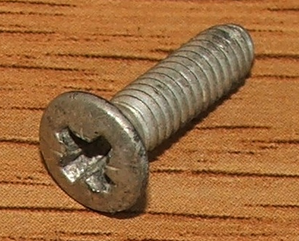
Published by LanthanumK
-
in
Elements
April 3 2012
2
03
/04
/April
/2012
15:39
I have compiled a list of sources for the elements that are available to the amateur chemist. Silver will be discussed here.
Silver is the most common and one of the most well-known precious metals. Occurring as a native metal in the earth's crust, it was a relatively easy task to extract silver for primitive people. Silver is a white, soft, and dense, and relatively unreactive. However, it does react with hydrogen sulfide to form a black tarnish of silver sulfide, even in trace amounts. Many silver compounds are light sensitive ( Silver Compounds in Light , another article I wrote), and were used in film photography. Silver is strongly antibacterial but is much less toxic than the other heavy metals. Silver dissolves in nitric acid but not in aqua regia because of the formation of an insoluble chloride layer. Silver forms a wide range of insoluble or slightly soluble salts, including the sulfate, chloride, bromide, and iodide, salts typically soluble for most other metals. Silver can be extracted from its ores by amalgamation with mercury, although this process is very environmentally unfriendly.
In element form: Sterling silver (92.5% silver 7.5% copper), as well as pure 3N silver metal (99.9% silver), are both used in jewelry. Silver plated relay contacts are relatively common. Some solders contain silver metal. Dental amalgams contain silver. Photographic film contains either silver iodide or silver bromide.
In compound form: Some prescription burn creams contain silver sulfadiazine. Silver oxide batteries contain a paste of silver oxide at the cathode instead of manganese dioxide in an alkaline battery.
Here is my sample of silver metal. It is a thin 99.9% silver wire purchased from a jewelry store.
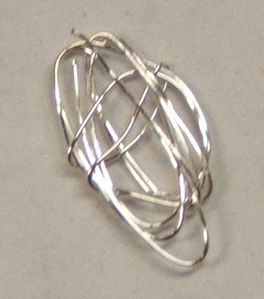
Published by LanthanumK
-
in
Elements










